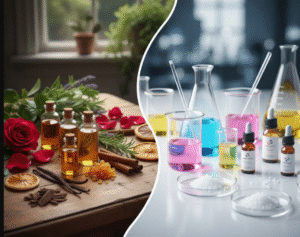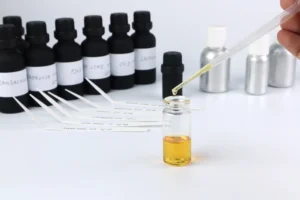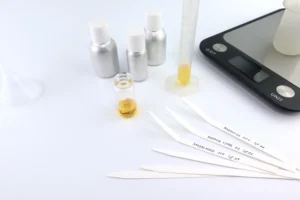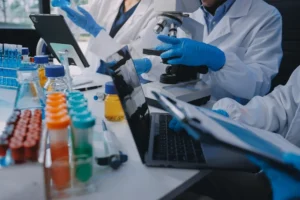You understand that the success of a fragrance is measured by its longevity and market performance. The secret lies not solely in natural ingredients, but in the skillful application of Aroma Chemicals to guarantee the scent’s persistence and quality.
So, what are the essential Aroma Chemicals? That’s the focus of today’s Jasmine article, which will also introduce you to the difference between them and natural ingredients, how you can effectively use them, and the most critical safety and quality standards you must adhere to.
What are the main aroma chemicals in perfumery?
These compounds form the foundation of modern fragrance formulation. A solid understanding of them is essential for you to accurately evaluate the true performance of the products you offer.
- Esters: Esters impart smooth, fruity nuances to fragrances, reminiscent of apple or pineapple. They are utilized to subtly dilute heavier notes and establish a harmonious blend across the scent layers without compromising the distinct character of the aroma.
- Aldehydes: The renown of classic French perfumery is often attributed to Aldehydes. They lend a sense of freshness and clarity to floral scents and are crucial for accentuating the top notes in high-end fragrances.
- Ketones: Ketones contribute depth and body to the fragrance base. They are frequently found in Oriental and musky compositions, where they are key to enhancing the perception of warmth and longevity, significantly improving the scent’s persistence on the skin.
- Terpenes: Derived from natural plants and resins, Terpenes imbue a powerful, natural woody or green scent. They serve as the cornerstone of many classic men’s colognes and fragrances.
- Lactones: Lactones provide fragrances with soft, creamy aromas, often likened to coconut milk. They are incorporated to elevate the perception of richness and smoothness, particularly in formulations designed for women’s perfumes.
What is the difference between synthetic and natural chemicals?
When you are weighing up various fragrance options, you must recognize that the source of the ingredient fundamentally dictates the perfume’s performance and commercial value. Therefore, you need a clear understanding of the core differences between natural raw materials and manufactured molecules to select the most appropriate option.
Ingredient Source and Production Cost
Natural ingredients are extracted from plants through complex and challenging processes. Consequently, their pricing is often volatile, fluctuating significantly with agricultural seasons and crop yields. In contrast, synthetic compounds are manufactured in labs in large volumes at a consistent price, ensuring cost stability and ease of supply for your production needs.
Olfactory Diversity and Innovation
Natural scents are inherently limited by what exists in nature, such as rose or sandalwood. However, synthetic compounds enable the creation of entirely new olfactory profiles, such as aquatic or metallic notes. This greatly expands your potential to introduce innovative and novel fragrances to the market.
Functional Performance and Longevity
Certain natural components are highly volatile or may contain uncontrolled allergens. Conversely, synthetic compounds are engineered to deliver superior longevity and consistent performance, with the added ability to adjust their formulation to minimize adverse allergic reactions in users.
Environmental Considerations and Sustainability
Extracting natural oils on a commercial scale consumes vast resources and can harm rare or endangered plant species. By utilizing synthetic alternatives, the environmental pressure on threatened flora is reduced, providing a sustainable and responsible solution for fragrance production.
To ensure your fragrance brand stands out, you need an expert partner in the perfumery industry. Contact our Jasmine Factory, today. Rest assured that by working with us, your brand will utilize the latest fragrance components while achieving full compliance with global standards.
Also read: Original Perfumes: Ingredients, How to Differentiate from Fake

Which chemicals are used in the perfume industry?
Having explored the differences between natural and synthetic ingredients, let us now introduce you to the most crucial chemical components (aroma chemicals) employed in this industry.
Complex Aroma Molecules
These encompass molecules that create specific scents, such as Vanillin or Coumarin, which have been fundamental to modern perfumery since its inception. They are precisely engineered compounds designed to mimic complex natural aromas.
Aldehydes and Ketones
This group provides the fragrance with its power in the opening (Aldehydes) or its weight in the base (Ketones). They are essential for scent diffusion, and accurately determining their quantity controls the sillage (projection) level of the perfume.
Chemical Fixatives and Synthetic Musks
These are utilized to bind the fragrance components and significantly extend the longevity of the scent on the skin. Selecting the correct type of fixative is crucial for preserving the perfume’s character and achieving its ultimate stability (tenacity).
Solvents and Alcohols
Ethyl alcohol is the standard solvent that carries the fragrance oils. Its function is to allow the scent to diffuse rapidly upon spraying, and its concentration percentage determines the final declared strength of the perfume (e.g., Eau de Parfum, Eau de Toilette).
Esters and Terpenes
Esters provide sweet, fruity touches to balance out heavier notes, while Terpenes highlight strong woody or herbal characteristics. The skillful blending of these components is what creates the necessary harmony and balance in the formulation.

How are aroma chemicals used in perfume manufacturing?
The process extends beyond simply mixing these compounds; it involves specialized laboratory procedures that ensure the safety and final stability of the product.
Weighting and Measurement
Accurately weigh every single aroma chemical (the concentrated oils) with extreme precision. Any slight deviation in quantity will alter the final character of the fragrance.
Olfactory Pyramid
The process begins by incorporating the heavier notes (the base notes) first, followed by the heart notes, and finally, the light top notes. This sequential addition ensures proper structural integrity.
Concentration Ratio
You must measure the quantity of concentrated fragrance oil and blend it with ethanol (ethyl alcohol) to establish the final strength (e.g., EDP or EDT).
Solubilization and Blending
Slowly and uniformly blend the concentrated oils with the ethanol (the solvent) to ensure the perfume diffuses effectively upon spraying. This is crucial for achieving optimal scent throw.
The Maturation Phase (Maceration)
Allow the fragrance blend to rest in a dedicated, controlled environment for several weeks. This period, known as maceration, permits the chemical molecules to interact and reach their ideal equilibrium.
Chilling and Filtration
Next, the perfume is chilled (cold stabilization) and then filtered to remove any impurities or precipitates that may have formed. This step guarantees the clarity and purity of the final liquid in the bottle.
Quality and Compliance Testing
Test the product to ensure its full compliance with international IFRA standards, and conduct a stability test before approving it for final bottling.
Partner with Jasmine to guarantee your fragrances are crafted with professional formulations that will ensure you achieve market distinction and reliability. Contact our team now.

Safety Protocols and Quality Best Practices for Handling Aroma Chemicals
These standards are just as crucial as the scent itself, as they build customer confidence in your product. So, what are the most prominent of these standards?
Comply with IFRA Standards
These are the international guidelines that define the maximum safe concentration limits for every chemical substance in fragrances. Adhering to them guarantees a product that is safe and non-sensitizing.
Ensure High Ingredient Purity
The chemical compounds used must be of high purity and must meet all required specifications. Impurities can severely compromise the final stability of the fragrance.
Perform Sensitization Testing
Every chemical compound that presents a risk of potential skin sensitization must be thoroughly tested. This determines the safe concentration that will not provoke any adverse reactions in the consumer.
Conduct Stability Tests
It is essential to select fragrance components that can withstand changes in temperature and light. This ensures that the perfume’s color and scent remain unaffected over time after bottling.
Maintain Proper Material Storage Conditions
Materials must be stored in a dark, cool, and tightly sealed environment. Exposure to light and heat alters their chemical structure and ultimately degrades the fragrance.
Provide Comprehensive Technical Documentation
This involves obtaining Certificates of Analysis (COA) that verify the chemical composition of each substance. This validates its source and quality, ensuring precise ingredient traceability.
Do not worry about ensuring your products meet these stringent criteria. Simply contact us, and our factory experts will take care of everything that needs to be done.
Also read: Safety Guidelines in Perfume Industry: Everything to Know

From Chemistry to Luxury: How Jasmine Professionally Utilizes Aroma Compounds
To create a successful fragrance, you must know how your partner transforms complex chemistry into a competitive advantage for your business. At Jasmine, we precisely employ fragrance components to ensure your product is luxurious, long-lasting, and fully compliant with all commercial standards.
- Long-Term Fragrance Tenacity: We select advanced chemical fixatives that ensure your perfumes endure for extended periods.
- Powerful Sillage and Impact: We focus on the precise integration of Aldehydes to guarantee a strong, bright scent diffusion.
- Uninterrupted Production Security: We rely on high-quality synthetic compounds, achieving stable pricing and supply independent of seasonal fluctuations.
- Regulatory Safety: We test every compound for full compliance with global IFRA standards, which opens the door for your export markets.
- Controlled Cost of Quality: We strategically utilize aroma compounds, allowing us to deliver exceptional quality at a logical production cost that maximizes your commercial profit.
To elevate your brand profitability and guarantee the quality of your products, contact the experts at Jasmine factory now. Start manufacturing your perfumes with us to achieve superior longevity and stable supply, ensuring your dominance in the market.
FAQs About aroma chemicals
What are the primary components of perfume formulation?
Perfumes are primarily composed of concentrated fragrance oils (whether naturally extracted or chemically synthesized), fixatives, and the main solvent, usually ethyl alcohol. These are blended in precise ratios to construct the olfactory pyramid of the scent.
What is the best alcohol concentration for perfume?
The optimal concentration depends on the desired final classification (e.g., EDP, EDT) of the fragrance. It typically ranges from 70% to 95% pure ethyl alcohol. Higher concentrations (such as 80-90%) are used in Parfum or Eau de Parfum formulations to ensure superior strength and longevity.
What are fixatives in perfumery?
These are heavy molecular weight chemical or natural substances, such as synthetic musks (like Ambroxan) or natural resins (like Benzoin). Their main function is to slow the evaporation rate of lighter components and bind the notes together to prolong the scent’s lifespan (longevity).
Which ingredient makes perfume last longer?
The longevity of a perfume is achieved by heavy molecular weight aroma compounds such as musk molecules and synthetic woods (like Iso E Super). These materials are placed in the base notes to linger on the skin for an extended period, acting as the primary fixative.
What is Fragrance Chemistry?
Fragrance Chemistry is a scientific discipline focused on studying the molecular structure of compounds responsible for scent, whether they are natural or lab-synthesized. This chemistry aids in creating novel aromas that do not exist in nature, while ensuring the safety and efficacy of the ingredients.